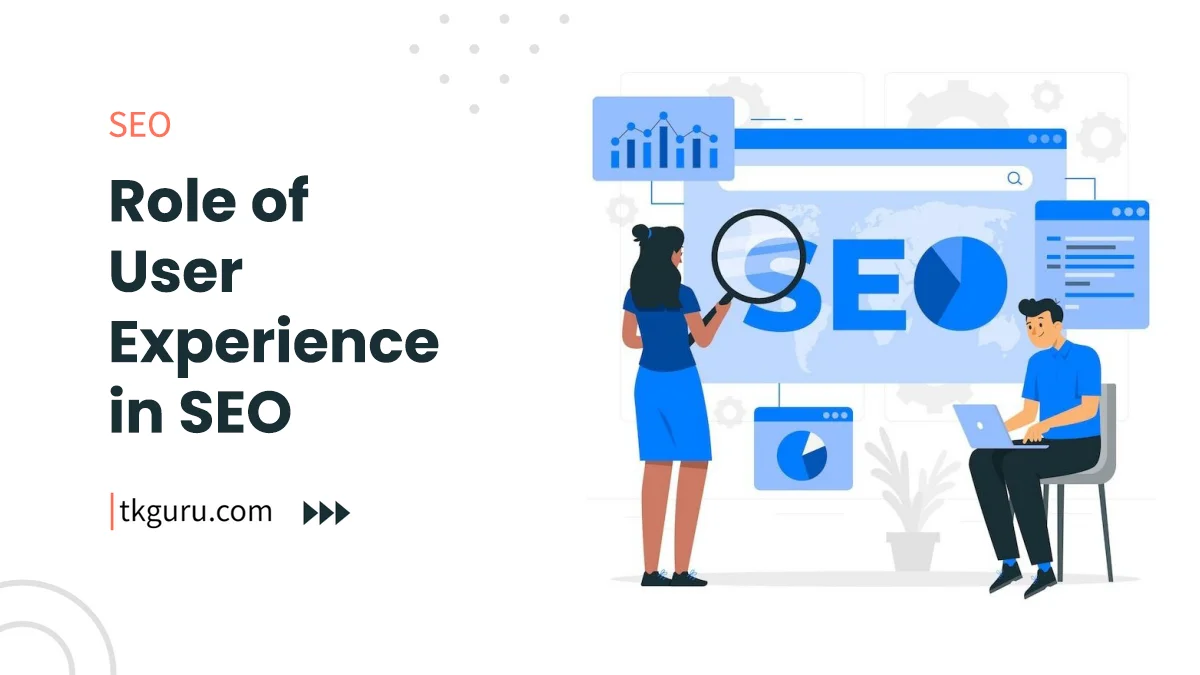Advertisements
Ratings

Role of User Experience in SEO – In the ever-evolving landscape of digital marketing, the relationship between user experience (UX) and search engine optimization (SEO) has become increasingly intertwined.
A harmonious blend of intuitive design, engaging content, and technical optimization can propel websites to higher rankings and foster user satisfaction.
In this comprehensive guide, we’ll explore the critical role that user experience plays in SEO, dissecting core aspects that impact rankings, user engagement signals, and the synergy between user-centric design principles and SEO strategies.
Contents
- 1. Understanding User Experience (UX): Beyond Aesthetics
- 2. Defining User Experience
- 3. The Components of UX
- 4. The Evolution of Search Engines and User Intent
- 5. From Keyword-Centric to User-Centric Search
- 6. Semantic Search and Natural Language Processing
- 7. Core Aspects of User Experience that Impact SEO
- 8. Website Speed and Performance
- 9. Mobile-Friendliness and Responsiveness
- 10. User-Friendly Navigation and Information Architecture
- 11. High-Quality and Engaging Content
- 12. User Engagement Signals and SEO
- 13. Dwell Time and Bounce Rate
- 14. Click-Through Rate (CTR) and Search Snippets
- 15. User-Centric Design Principles and SEO Synergy
- 16. Accessibility and Inclusivity
- 17. Page Layout and Visual Hierarchy
- 18. The SEO Benefits of Prioritizing User Experience
- 19. Improved Search Rankings
- 20. Reduced Bounce Rates and Increased Dwell Time
- 21. Enhanced User Engagement and Conversions
- Case Studies: User Experience Transforming SEO Performance
- Conclusion: Unlocking SEO Potential through User Experience
- Conclusion: A Synergistic Approach to Digital Success
- Role of User Experience in SEO FAQs
1. Understanding User Experience (UX): Beyond Aesthetics
2. Defining User Experience
User experience encompasses the overall interaction a visitor has with a website, app, or digital platform.
It goes beyond visual aesthetics and encompasses elements such as ease of navigation, page loading speed, and the satisfaction derived from the interaction.
3. The Components of UX
- Usability: How easily visitors can navigate and interact with your website.
- Accessibility: Ensuring your website is accessible to users of all abilities.
- Credibility: Building trust through reliable content and secure transactions.
- Usefulness: Providing content that addresses user needs and fulfills their goals.
- Desirability: Crafting a visually appealing and engaging digital environment.
4. The Evolution of Search Engines and User Intent
5. From Keyword-Centric to User-Centric Search
Search engines have evolved from focusing solely on keywords to prioritizing user intent. Google’s algorithm updates aim to provide users with results that best align with their needs, thus requiring websites to focus on user-centered design.
6. Semantic Search and Natural Language Processing
Google’s shift towards semantic search and natural language processing enables search engines to understand user queries in context. This means that optimizing for specific long-tail keywords is just as important as understanding user intent.
7. Core Aspects of User Experience that Impact SEO
8. Website Speed and Performance
A fast-loading website is crucial for user satisfaction and SEO success. Slow loading times can lead to high bounce rates and negatively impact search rankings.
| Page Speed Factor | Impact on SEO and User Experience |
|---|---|
| Fast Loading Times | Reduce bounce rates and improve user engagement. |
| Slow Loading Times | Frustrate users, increase bounce rates, and harm search rankings. |
9. Mobile-Friendliness and Responsiveness
As the world becomes increasingly mobile-centric, ensuring your website is mobile-friendly and responsive is paramount. Google’s mobile-first indexing means that mobile optimization directly impacts search rankings.
| Mobile Optimization Factor | Impact on SEO and User Experience |
|---|---|
| Mobile-Friendly Design | Improve search visibility and enhance user experience on mobile. |
| Non-Responsive Design | Harm search rankings and lead to a frustrating mobile experience. |
An intuitive navigation system enhances user experience by making it easier for visitors to find the content they seek. Properly structured menus and internal linking contribute to lower bounce rates and longer time-on-page.
| Navigation Factor | Impact on SEO and User Experience |
|---|---|
| Clear Navigation Structure | Reduce bounce rates and increase time spent on the website. |
| Confusing or Non-Intuitive Navigation | Frustrate users and lead to high bounce rates. |
11. High-Quality and Engaging Content
Quality content tailored to user needs is the cornerstone of positive user experience. Engaging, informative content encourages users to spend more time on your website and reduces bounce rates.
| Content Quality Factor | Impact on SEO and User Experience |
|---|---|
| Valuable and Informative Content | Keep users engaged, improve dwell time, and encourage sharing. |
| Thin or Irrelevant Content | Lead to high bounce rates and negatively affect SEO performance. |
12. User Engagement Signals and SEO
13. Dwell Time and Bounce Rate
Dwell time measures the amount of time a user spends on your website after clicking on a search result. A longer dwell time indicates that visitors find your content valuable, positively impacting SEO.
| Engagement Signal | Impact on SEO and User Experience |
|---|---|
| Longer Dwell Time | Indicate content relevance and improve search rankings. |
| High Bounce Rate | Suggest user dissatisfaction and negatively affect SEO performance. |
14. Click-Through Rate (CTR) and Search Snippets
Crafting compelling meta titles and descriptions can lead to higher click-through rates (CTR), indicating that users find your content relevant and enticing.
| Click-Through Rate Factor | Impact on SEO and User Experience |
|---|---|
| Higher CTR | Improve search rankings by signaling content relevance. |
| Low CTR | Suggest that content might not be meeting user expectations. |
15. User-Centric Design Principles and SEO Synergy
16. Accessibility and Inclusivity
Designing with accessibility in mind ensures that all users, regardless of disabilities, can access and interact with your content. This contributes to positive user experience and can improve SEO.
| Accessibility Factor | Impact on SEO and User Experience |
|---|---|
| Accessible Design | Improve user satisfaction and SEO performance. |
| Inaccessible Design | Exclude users with disabilities and potentially harm SEO rankings. |
17. Page Layout and Visual Hierarchy
A well-organized page layout and clear visual hierarchy contribute to a seamless user experience. This encourages users to engage with your content and navigate your website effectively.
| Visual Hierarchy Factor | Impact on SEO and User Experience |
|---|---|
| Clear Visual Hierarchy | Enhance content consumption and reduce bounce rates. |
| Chaotic Layout | Confuse users and lead to high bounce rates. |
18. The SEO Benefits of Prioritizing User Experience
19. Improved Search Rankings
Google’s algorithm rewards websites that provide positive user experiences by ranking them higher in search results.
20. Reduced Bounce Rates and Increased Dwell Time
A user-friendly website encourages visitors to stay longer and explore more pages, leading to lower bounce rates and higher dwell times.
21. Enhanced User Engagement and Conversions
Engaging and user-focused design fosters a deeper connection between visitors and your website, potentially leading to increased conversions and brand loyalty.
Case Studies: User Experience Transforming SEO Performance
Here are a couple of case studies that highlight how user experience has transformed SEO performance:
Case Study 1: E-Commerce Revolution – Speed Boosts Sales
Background: A well-established e-commerce website specializing in electronics faced challenges with high bounce rates and a decline in sales. Users were frustrated with slow loading times, leading to abandoned shopping carts and lost revenue.
Strategy: The e-commerce team undertook a comprehensive site speed optimization campaign to enhance user experience and boost SEO performance.
Implementation:
- Server Optimization: The website migrated to a faster and more reliable server, reducing server response times.
- Image Compression: All product images were optimized without compromising quality, reducing page load times significantly.
- Browser Caching: Browser caching was implemented to store static resources, ensuring quicker loading for returning visitors.
- Minification: CSS and JavaScript files were minified to reduce code size and improve rendering speed.
- Mobile Optimization: The website embraced a responsive design, ensuring fast loading and optimal performance on mobile devices.
Results: The results were remarkable:
- Bounce rates decreased by 25%, indicating improved user engagement.
- Page load times were cut in half, resulting in a 15% increase in conversion rates.
- Search rankings improved due to reduced bounce rates and improved user experience signals.
- Overall revenue increased by 20% as users were more likely to complete purchases.
Case Study 2: Local Business Boost – Speed Enhances Local SEO
Background: A local bakery struggled to attract online customers despite a loyal in-store following. High bounce rates and poor search visibility hindered their digital growth.
Strategy: The bakery’s marketing team recognized the importance of site speed in local SEO and devised a plan to revamp their online presence.
Implementation:
- Speed Audit: A thorough speed audit was conducted to identify bottlenecks and areas for improvement.
- Image Optimization: High-resolution images of baked goods were resized and optimized.
- Content Delivery Network (CDN): A CDN was implemented to distribute website content efficiently to users across different geographical locations.
- Google My Business Optimization: The bakery’s Google My Business profile was fully optimized, including accurate business information and customer reviews.
- Local Structured Data Markup: Structured data markup was added to the website to enhance local search results.
Results: The bakery’s digital transformation yielded impressive outcomes:
- Page load times were reduced by 40%, resulting in a 30% decrease in bounce rates.
- Local search rankings improved significantly, leading to a 50% increase in online visibility.
- Google My Business engagement soared, with more customers leaving positive reviews and inquiries.
- Online orders doubled within three months, contributing to a notable revenue increase.
Conclusion: Unlocking SEO Potential through User Experience
These case studies underline the transformative potential of prioritizing user experience in SEO strategies.
Site speed, a crucial aspect of user experience, plays a pivotal role in shaping how visitors engage with a website and how search engines perceive its value.
By optimizing for site speed, businesses can achieve reduced bounce rates, improved user engagement signals, and enhanced search visibility.
The synergy between user experience and SEO isn’t just a theoretical concept; it’s a proven strategy that has the power to reshape online performance, drive conversions, and lead to sustainable success in a competitive digital landscape.
Conclusion: A Synergistic Approach to Digital Success
In the dynamic realm of digital marketing, user experience and SEO are intrinsically connected. By creating a seamless and engaging digital journey, you not only satisfy user expectations but also enhance your website’s search engine visibility and rankings.
The art of optimizing user experience isn’t just about aesthetics; it’s about creating a harmonious blend of design, functionality, and relevance that delights users and captivates search engines.
As you prioritize user experience, you embark on a journey towards improved rankings, higher engagement, and sustainable online success.
Role of User Experience in SEO FAQs
What is user experience (UX) in the context of SEO?
User experience (UX) in SEO refers to the overall experience that visitors have when interacting with your website.
It encompasses factors like ease of navigation, page load speed, mobile-friendliness, and the quality of content.
Why is user experience important for SEO?
User experience is important for SEO because search engines, particularly Google, aim to deliver the best possible results to users.
Websites that provide a positive user experience tend to have lower bounce rates, longer dwell times, and higher engagement, which are positive signals to search engines.
How does page load speed affect SEO and user experience?
Page load speed directly impacts both SEO and user experience. Faster-loading pages result in lower bounce rates, higher user satisfaction, and improved search rankings.
Google considers page speed as a ranking factor, especially for mobile searches.
Does mobile-friendliness impact SEO and user experience?
Yes, mobile-friendliness is crucial for both SEO and user experience. As mobile device usage increases, Google prioritizes mobile-friendly websites in search results.
A responsive design ensures your site displays well on various screen sizes, leading to better user engagement.
How can I improve user experience on my website for better SEO?
To improve user experience for better SEO outcomes:
- Ensure fast page load times.
- Use a mobile-responsive design.
- Create high-quality, relevant, and easy-to-read content.
- Optimize site navigation and structure.
- Provide clear calls-to-action and intuitive forms.
User experience and SEO are closely intertwined. A website that provides an excellent user experience is more likely to attract and retain visitors, which can lead to better search engine rankings over time.
Focus on optimizing your website's design, functionality, and content to create a positive and engaging user experience.
| Web Hosting | Website |
| WordPress | Google Adsense |
| SEO | Affiliate Marketing |
| Blogging | YouTube |
Recent Posts
- Top 6 SEO Companies in Ahmedabad 2024: Unlock Success with the Top SEO Companies in Ahmedabad
- Top 5 SEO Companies in Kanpur 2024: Discover the Top-Rated SEO Companies in Kanpur
- Quality vs Quantity: The Importance of High-Quality Backlinks
- E-A-T and SEO: Expertise, Authoritativeness, Trustworthiness
Related Tags
user experience marketing examples, how can a digital marketer create a great user experience with a website’s images?, user experience in digital marketing, seo ux best practices, importance of user experience in digital world, ux and seo, ui in digital marketing, why should a digital marketer keep web page titles brief but descriptive?






